Australian Aboriginal Health: Assimilation Policy and its Effects
VerifiedAdded on 2022/11/29
|11
|2994
|260
Essay
AI Summary
This essay explores the historical context and impact of the Assimilation Policy of 1961 on the health and well-being of young Australian Aboriginal people. It examines the policy's intent to integrate Aboriginals into mainstream society and its effects on identity, racism, smoking during pregnancy, traditional birthing practices, and educational attainment. The essay highlights the disparities in health outcomes, including higher rates of infectious diseases, HIV/AIDS, and lower life expectancy. It also discusses the links between the policy and present health status, including the influence of identity and racism, the impact of smoking during pregnancy, and the importance of education and employment opportunities. The essay concludes with a reflection on culturally safe practices to help close the health gap between Aboriginal and non-Aboriginal populations. The analysis provides insights into the long-term consequences of assimilation policies on indigenous communities and emphasizes the importance of culturally sensitive healthcare approaches.
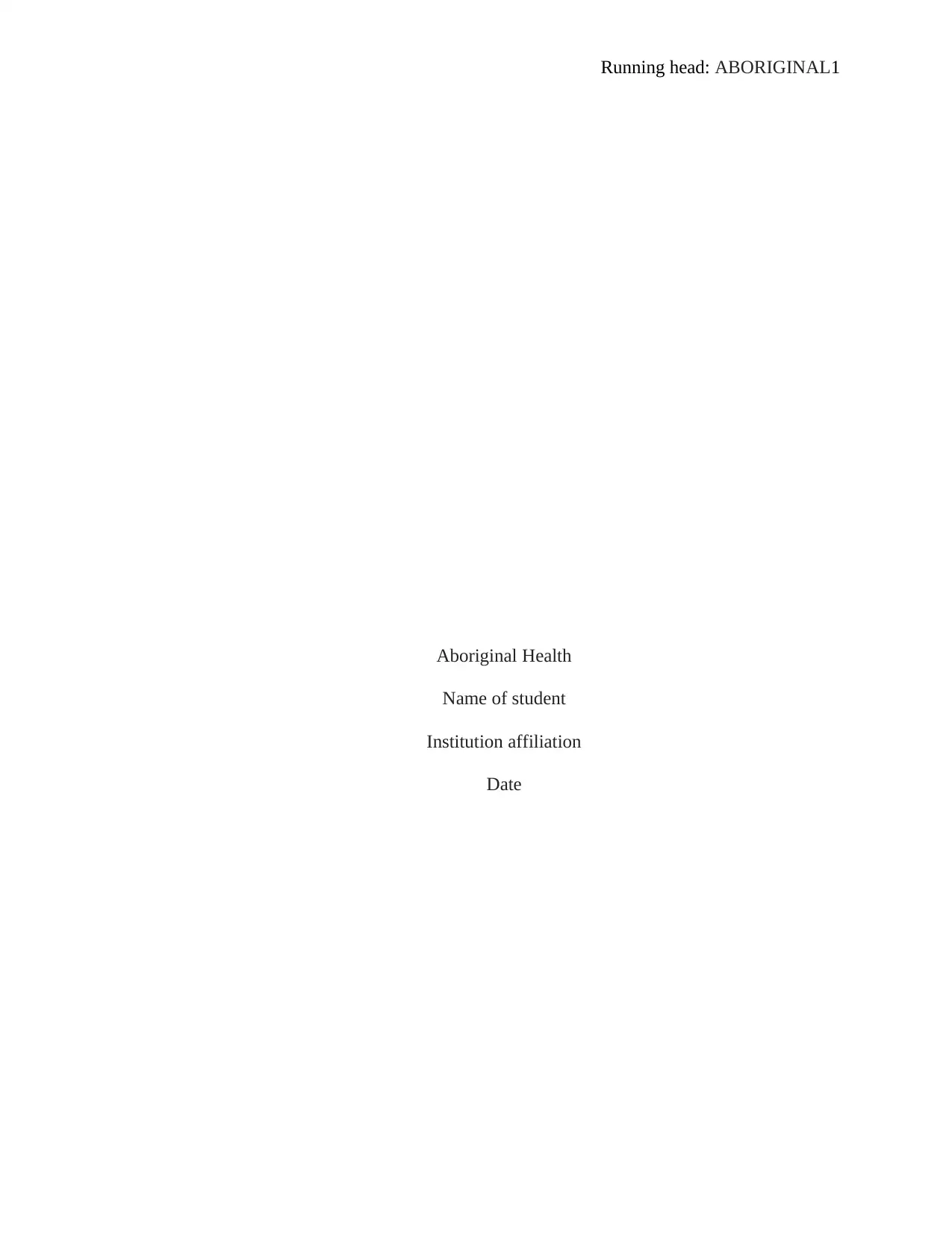
Running head: ABORIGINAL1
Aboriginal Health
Name of student
Institution affiliation
Date
Aboriginal Health
Name of student
Institution affiliation
Date
Paraphrase This Document
Need a fresh take? Get an instant paraphrase of this document with our AI Paraphraser
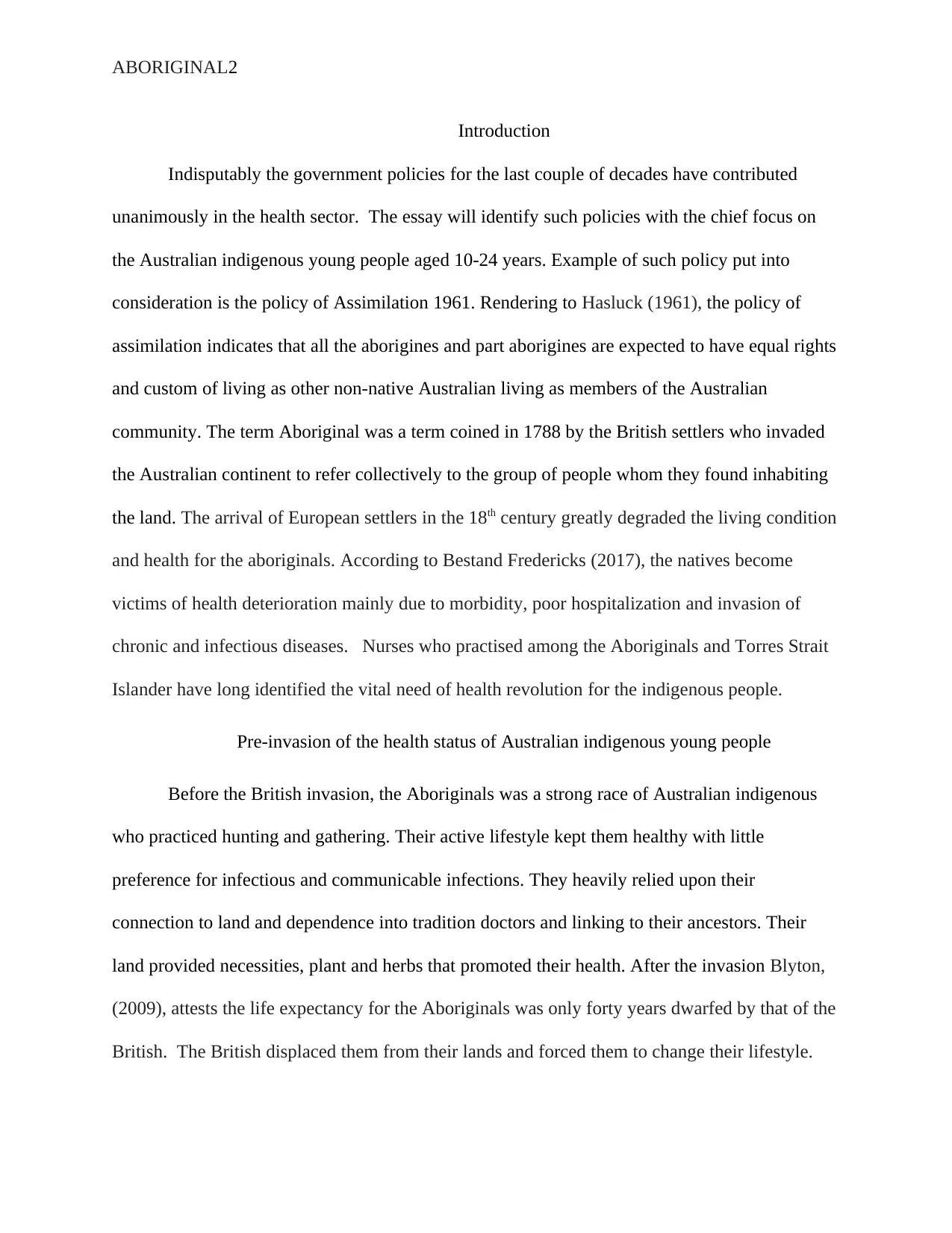
ABORIGINAL2
Introduction
Indisputably the government policies for the last couple of decades have contributed
unanimously in the health sector. The essay will identify such policies with the chief focus on
the Australian indigenous young people aged 10-24 years. Example of such policy put into
consideration is the policy of Assimilation 1961. Rendering to Hasluck (1961), the policy of
assimilation indicates that all the aborigines and part aborigines are expected to have equal rights
and custom of living as other non-native Australian living as members of the Australian
community. The term Aboriginal was a term coined in 1788 by the British settlers who invaded
the Australian continent to refer collectively to the group of people whom they found inhabiting
the land. The arrival of European settlers in the 18th century greatly degraded the living condition
and health for the aboriginals. According to Bestand Fredericks (2017), the natives become
victims of health deterioration mainly due to morbidity, poor hospitalization and invasion of
chronic and infectious diseases. Nurses who practised among the Aboriginals and Torres Strait
Islander have long identified the vital need of health revolution for the indigenous people.
Pre-invasion of the health status of Australian indigenous young people
Before the British invasion, the Aboriginals was a strong race of Australian indigenous
who practiced hunting and gathering. Their active lifestyle kept them healthy with little
preference for infectious and communicable infections. They heavily relied upon their
connection to land and dependence into tradition doctors and linking to their ancestors. Their
land provided necessities, plant and herbs that promoted their health. After the invasion Blyton,
(2009), attests the life expectancy for the Aboriginals was only forty years dwarfed by that of the
British. The British displaced them from their lands and forced them to change their lifestyle.
Introduction
Indisputably the government policies for the last couple of decades have contributed
unanimously in the health sector. The essay will identify such policies with the chief focus on
the Australian indigenous young people aged 10-24 years. Example of such policy put into
consideration is the policy of Assimilation 1961. Rendering to Hasluck (1961), the policy of
assimilation indicates that all the aborigines and part aborigines are expected to have equal rights
and custom of living as other non-native Australian living as members of the Australian
community. The term Aboriginal was a term coined in 1788 by the British settlers who invaded
the Australian continent to refer collectively to the group of people whom they found inhabiting
the land. The arrival of European settlers in the 18th century greatly degraded the living condition
and health for the aboriginals. According to Bestand Fredericks (2017), the natives become
victims of health deterioration mainly due to morbidity, poor hospitalization and invasion of
chronic and infectious diseases. Nurses who practised among the Aboriginals and Torres Strait
Islander have long identified the vital need of health revolution for the indigenous people.
Pre-invasion of the health status of Australian indigenous young people
Before the British invasion, the Aboriginals was a strong race of Australian indigenous
who practiced hunting and gathering. Their active lifestyle kept them healthy with little
preference for infectious and communicable infections. They heavily relied upon their
connection to land and dependence into tradition doctors and linking to their ancestors. Their
land provided necessities, plant and herbs that promoted their health. After the invasion Blyton,
(2009), attests the life expectancy for the Aboriginals was only forty years dwarfed by that of the
British. The British displaced them from their lands and forced them to change their lifestyle.
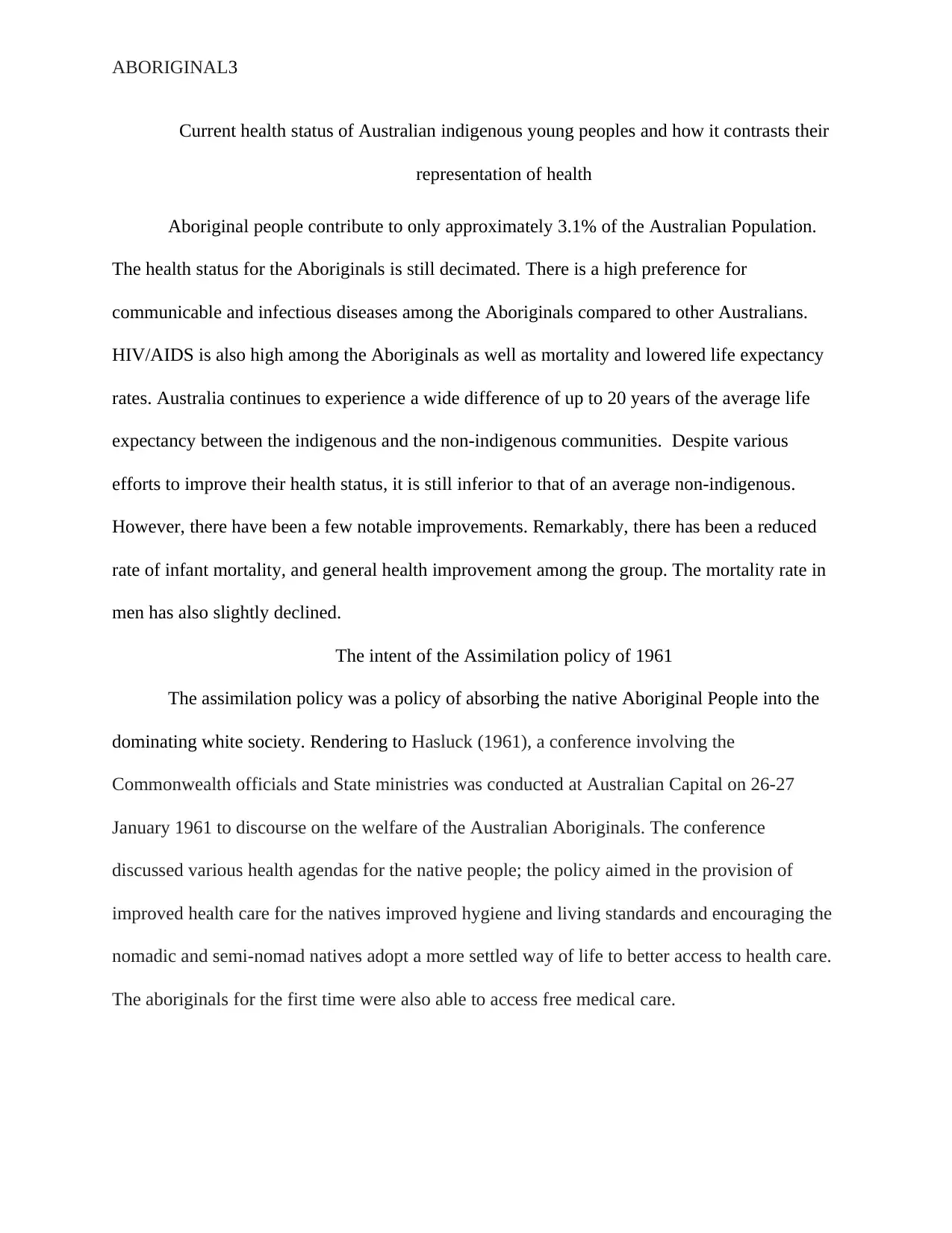
ABORIGINAL3
Current health status of Australian indigenous young peoples and how it contrasts their
representation of health
Aboriginal people contribute to only approximately 3.1% of the Australian Population.
The health status for the Aboriginals is still decimated. There is a high preference for
communicable and infectious diseases among the Aboriginals compared to other Australians.
HIV/AIDS is also high among the Aboriginals as well as mortality and lowered life expectancy
rates. Australia continues to experience a wide difference of up to 20 years of the average life
expectancy between the indigenous and the non-indigenous communities. Despite various
efforts to improve their health status, it is still inferior to that of an average non-indigenous.
However, there have been a few notable improvements. Remarkably, there has been a reduced
rate of infant mortality, and general health improvement among the group. The mortality rate in
men has also slightly declined.
The intent of the Assimilation policy of 1961
The assimilation policy was a policy of absorbing the native Aboriginal People into the
dominating white society. Rendering to Hasluck (1961), a conference involving the
Commonwealth officials and State ministries was conducted at Australian Capital on 26-27
January 1961 to discourse on the welfare of the Australian Aboriginals. The conference
discussed various health agendas for the native people; the policy aimed in the provision of
improved health care for the natives improved hygiene and living standards and encouraging the
nomadic and semi-nomad natives adopt a more settled way of life to better access to health care.
The aboriginals for the first time were also able to access free medical care.
Current health status of Australian indigenous young peoples and how it contrasts their
representation of health
Aboriginal people contribute to only approximately 3.1% of the Australian Population.
The health status for the Aboriginals is still decimated. There is a high preference for
communicable and infectious diseases among the Aboriginals compared to other Australians.
HIV/AIDS is also high among the Aboriginals as well as mortality and lowered life expectancy
rates. Australia continues to experience a wide difference of up to 20 years of the average life
expectancy between the indigenous and the non-indigenous communities. Despite various
efforts to improve their health status, it is still inferior to that of an average non-indigenous.
However, there have been a few notable improvements. Remarkably, there has been a reduced
rate of infant mortality, and general health improvement among the group. The mortality rate in
men has also slightly declined.
The intent of the Assimilation policy of 1961
The assimilation policy was a policy of absorbing the native Aboriginal People into the
dominating white society. Rendering to Hasluck (1961), a conference involving the
Commonwealth officials and State ministries was conducted at Australian Capital on 26-27
January 1961 to discourse on the welfare of the Australian Aboriginals. The conference
discussed various health agendas for the native people; the policy aimed in the provision of
improved health care for the natives improved hygiene and living standards and encouraging the
nomadic and semi-nomad natives adopt a more settled way of life to better access to health care.
The aboriginals for the first time were also able to access free medical care.
⊘ This is a preview!⊘
Do you want full access?
Subscribe today to unlock all pages.

Trusted by 1+ million students worldwide
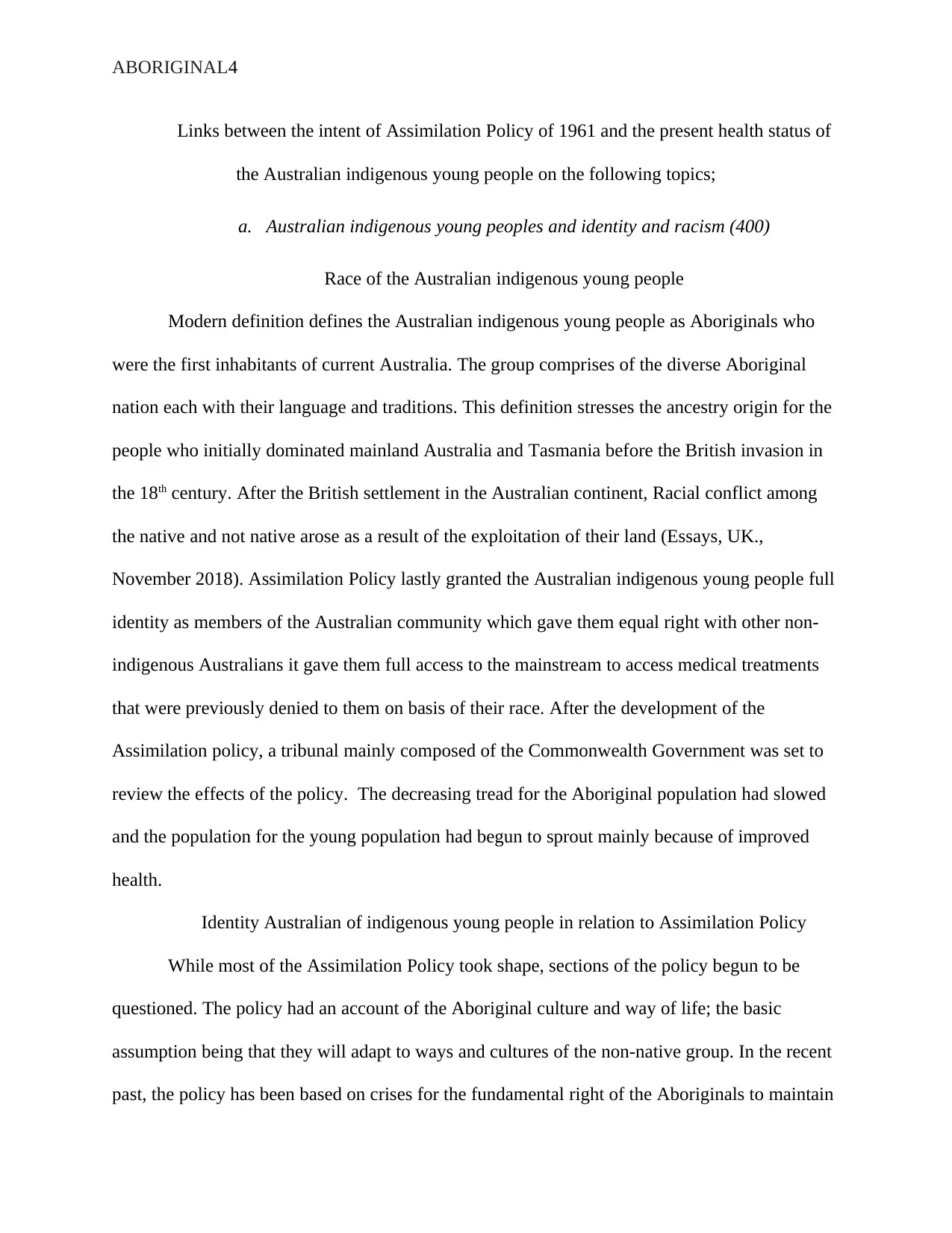
ABORIGINAL4
Links between the intent of Assimilation Policy of 1961 and the present health status of
the Australian indigenous young people on the following topics;
a. Australian indigenous young peoples and identity and racism (400)
Race of the Australian indigenous young people
Modern definition defines the Australian indigenous young people as Aboriginals who
were the first inhabitants of current Australia. The group comprises of the diverse Aboriginal
nation each with their language and traditions. This definition stresses the ancestry origin for the
people who initially dominated mainland Australia and Tasmania before the British invasion in
the 18th century. After the British settlement in the Australian continent, Racial conflict among
the native and not native arose as a result of the exploitation of their land (Essays, UK.,
November 2018). Assimilation Policy lastly granted the Australian indigenous young people full
identity as members of the Australian community which gave them equal right with other non-
indigenous Australians it gave them full access to the mainstream to access medical treatments
that were previously denied to them on basis of their race. After the development of the
Assimilation policy, a tribunal mainly composed of the Commonwealth Government was set to
review the effects of the policy. The decreasing tread for the Aboriginal population had slowed
and the population for the young population had begun to sprout mainly because of improved
health.
Identity Australian of indigenous young people in relation to Assimilation Policy
While most of the Assimilation Policy took shape, sections of the policy begun to be
questioned. The policy had an account of the Aboriginal culture and way of life; the basic
assumption being that they will adapt to ways and cultures of the non-native group. In the recent
past, the policy has been based on crises for the fundamental right of the Aboriginals to maintain
Links between the intent of Assimilation Policy of 1961 and the present health status of
the Australian indigenous young people on the following topics;
a. Australian indigenous young peoples and identity and racism (400)
Race of the Australian indigenous young people
Modern definition defines the Australian indigenous young people as Aboriginals who
were the first inhabitants of current Australia. The group comprises of the diverse Aboriginal
nation each with their language and traditions. This definition stresses the ancestry origin for the
people who initially dominated mainland Australia and Tasmania before the British invasion in
the 18th century. After the British settlement in the Australian continent, Racial conflict among
the native and not native arose as a result of the exploitation of their land (Essays, UK.,
November 2018). Assimilation Policy lastly granted the Australian indigenous young people full
identity as members of the Australian community which gave them equal right with other non-
indigenous Australians it gave them full access to the mainstream to access medical treatments
that were previously denied to them on basis of their race. After the development of the
Assimilation policy, a tribunal mainly composed of the Commonwealth Government was set to
review the effects of the policy. The decreasing tread for the Aboriginal population had slowed
and the population for the young population had begun to sprout mainly because of improved
health.
Identity Australian of indigenous young people in relation to Assimilation Policy
While most of the Assimilation Policy took shape, sections of the policy begun to be
questioned. The policy had an account of the Aboriginal culture and way of life; the basic
assumption being that they will adapt to ways and cultures of the non-native group. In the recent
past, the policy has been based on crises for the fundamental right of the Aboriginals to maintain
Paraphrase This Document
Need a fresh take? Get an instant paraphrase of this document with our AI Paraphraser
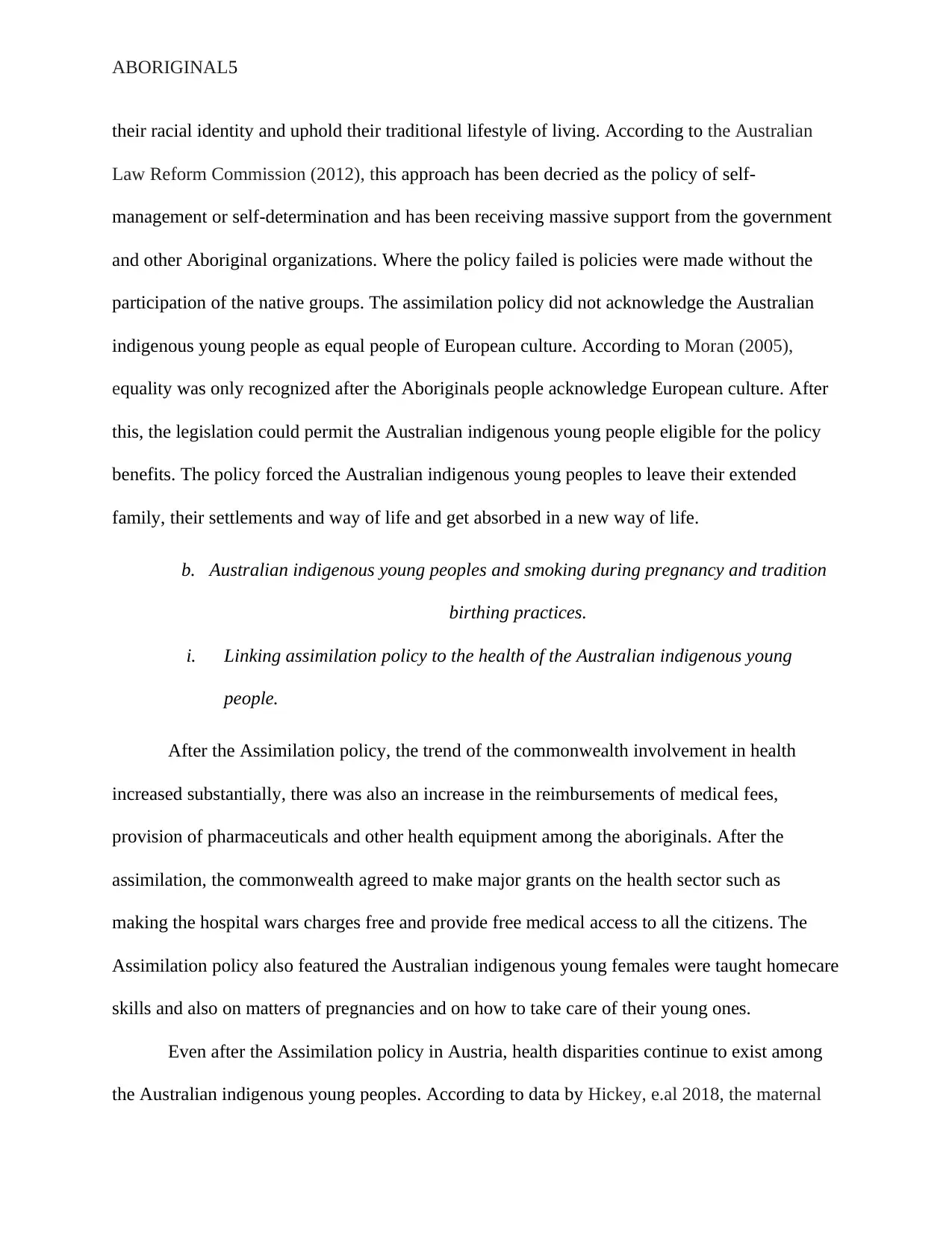
ABORIGINAL5
their racial identity and uphold their traditional lifestyle of living. According to the Australian
Law Reform Commission (2012), this approach has been decried as the policy of self-
management or self-determination and has been receiving massive support from the government
and other Aboriginal organizations. Where the policy failed is policies were made without the
participation of the native groups. The assimilation policy did not acknowledge the Australian
indigenous young people as equal people of European culture. According to Moran (2005),
equality was only recognized after the Aboriginals people acknowledge European culture. After
this, the legislation could permit the Australian indigenous young people eligible for the policy
benefits. The policy forced the Australian indigenous young peoples to leave their extended
family, their settlements and way of life and get absorbed in a new way of life.
b. Australian indigenous young peoples and smoking during pregnancy and tradition
birthing practices.
i. Linking assimilation policy to the health of the Australian indigenous young
people.
After the Assimilation policy, the trend of the commonwealth involvement in health
increased substantially, there was also an increase in the reimbursements of medical fees,
provision of pharmaceuticals and other health equipment among the aboriginals. After the
assimilation, the commonwealth agreed to make major grants on the health sector such as
making the hospital wars charges free and provide free medical access to all the citizens. The
Assimilation policy also featured the Australian indigenous young females were taught homecare
skills and also on matters of pregnancies and on how to take care of their young ones.
Even after the Assimilation policy in Austria, health disparities continue to exist among
the Australian indigenous young peoples. According to data by Hickey, e.al 2018, the maternal
their racial identity and uphold their traditional lifestyle of living. According to the Australian
Law Reform Commission (2012), this approach has been decried as the policy of self-
management or self-determination and has been receiving massive support from the government
and other Aboriginal organizations. Where the policy failed is policies were made without the
participation of the native groups. The assimilation policy did not acknowledge the Australian
indigenous young people as equal people of European culture. According to Moran (2005),
equality was only recognized after the Aboriginals people acknowledge European culture. After
this, the legislation could permit the Australian indigenous young people eligible for the policy
benefits. The policy forced the Australian indigenous young peoples to leave their extended
family, their settlements and way of life and get absorbed in a new way of life.
b. Australian indigenous young peoples and smoking during pregnancy and tradition
birthing practices.
i. Linking assimilation policy to the health of the Australian indigenous young
people.
After the Assimilation policy, the trend of the commonwealth involvement in health
increased substantially, there was also an increase in the reimbursements of medical fees,
provision of pharmaceuticals and other health equipment among the aboriginals. After the
assimilation, the commonwealth agreed to make major grants on the health sector such as
making the hospital wars charges free and provide free medical access to all the citizens. The
Assimilation policy also featured the Australian indigenous young females were taught homecare
skills and also on matters of pregnancies and on how to take care of their young ones.
Even after the Assimilation policy in Austria, health disparities continue to exist among
the Australian indigenous young peoples. According to data by Hickey, e.al 2018, the maternal
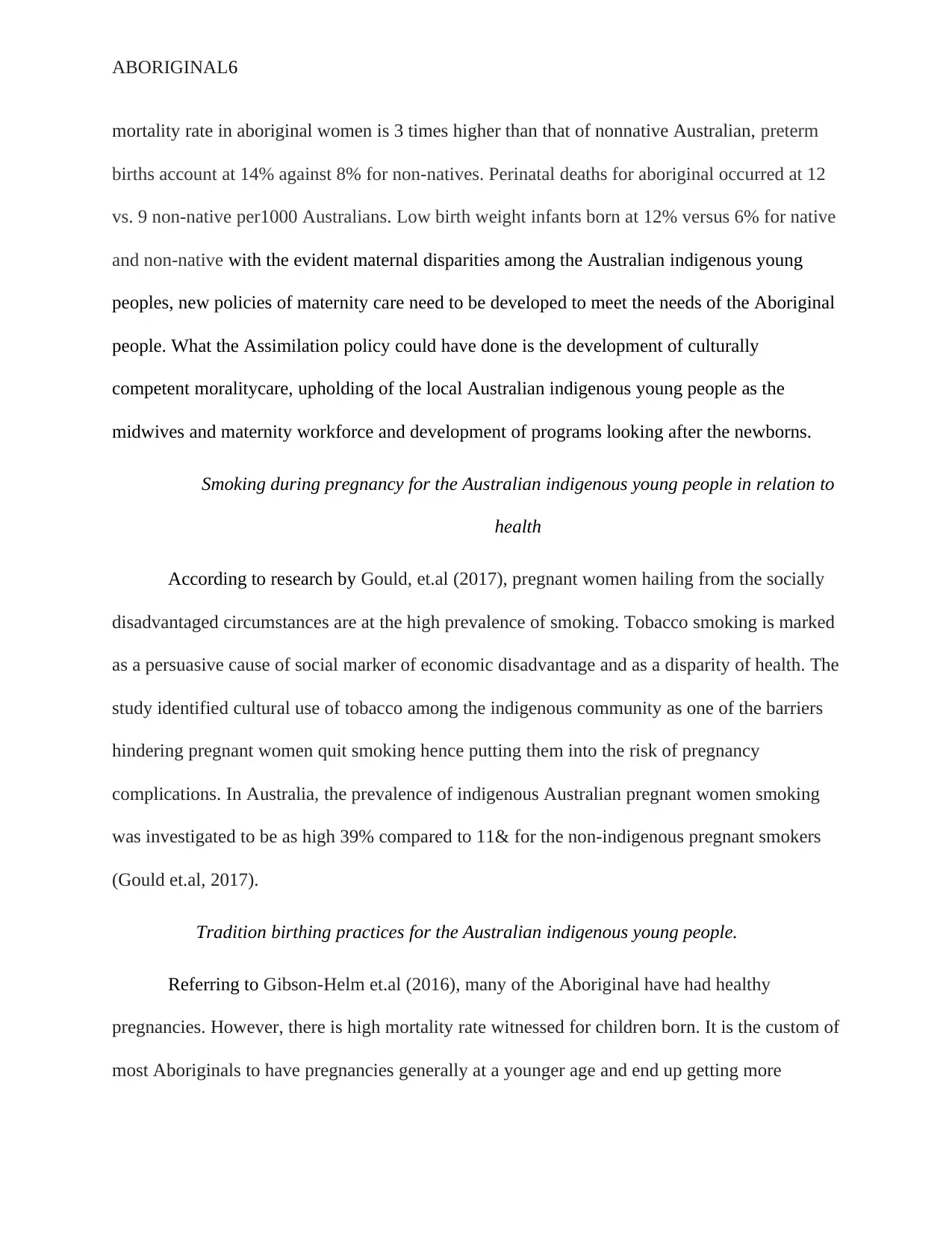
ABORIGINAL6
mortality rate in aboriginal women is 3 times higher than that of nonnative Australian, preterm
births account at 14% against 8% for non-natives. Perinatal deaths for aboriginal occurred at 12
vs. 9 non-native per1000 Australians. Low birth weight infants born at 12% versus 6% for native
and non-native with the evident maternal disparities among the Australian indigenous young
peoples, new policies of maternity care need to be developed to meet the needs of the Aboriginal
people. What the Assimilation policy could have done is the development of culturally
competent moralitycare, upholding of the local Australian indigenous young people as the
midwives and maternity workforce and development of programs looking after the newborns.
Smoking during pregnancy for the Australian indigenous young people in relation to
health
According to research by Gould, et.al (2017), pregnant women hailing from the socially
disadvantaged circumstances are at the high prevalence of smoking. Tobacco smoking is marked
as a persuasive cause of social marker of economic disadvantage and as a disparity of health. The
study identified cultural use of tobacco among the indigenous community as one of the barriers
hindering pregnant women quit smoking hence putting them into the risk of pregnancy
complications. In Australia, the prevalence of indigenous Australian pregnant women smoking
was investigated to be as high 39% compared to 11& for the non-indigenous pregnant smokers
(Gould et.al, 2017).
Tradition birthing practices for the Australian indigenous young people.
Referring to Gibson-Helm et.al (2016), many of the Aboriginal have had healthy
pregnancies. However, there is high mortality rate witnessed for children born. It is the custom of
most Aboriginals to have pregnancies generally at a younger age and end up getting more
mortality rate in aboriginal women is 3 times higher than that of nonnative Australian, preterm
births account at 14% against 8% for non-natives. Perinatal deaths for aboriginal occurred at 12
vs. 9 non-native per1000 Australians. Low birth weight infants born at 12% versus 6% for native
and non-native with the evident maternal disparities among the Australian indigenous young
peoples, new policies of maternity care need to be developed to meet the needs of the Aboriginal
people. What the Assimilation policy could have done is the development of culturally
competent moralitycare, upholding of the local Australian indigenous young people as the
midwives and maternity workforce and development of programs looking after the newborns.
Smoking during pregnancy for the Australian indigenous young people in relation to
health
According to research by Gould, et.al (2017), pregnant women hailing from the socially
disadvantaged circumstances are at the high prevalence of smoking. Tobacco smoking is marked
as a persuasive cause of social marker of economic disadvantage and as a disparity of health. The
study identified cultural use of tobacco among the indigenous community as one of the barriers
hindering pregnant women quit smoking hence putting them into the risk of pregnancy
complications. In Australia, the prevalence of indigenous Australian pregnant women smoking
was investigated to be as high 39% compared to 11& for the non-indigenous pregnant smokers
(Gould et.al, 2017).
Tradition birthing practices for the Australian indigenous young people.
Referring to Gibson-Helm et.al (2016), many of the Aboriginal have had healthy
pregnancies. However, there is high mortality rate witnessed for children born. It is the custom of
most Aboriginals to have pregnancies generally at a younger age and end up getting more
⊘ This is a preview!⊘
Do you want full access?
Subscribe today to unlock all pages.

Trusted by 1+ million students worldwide
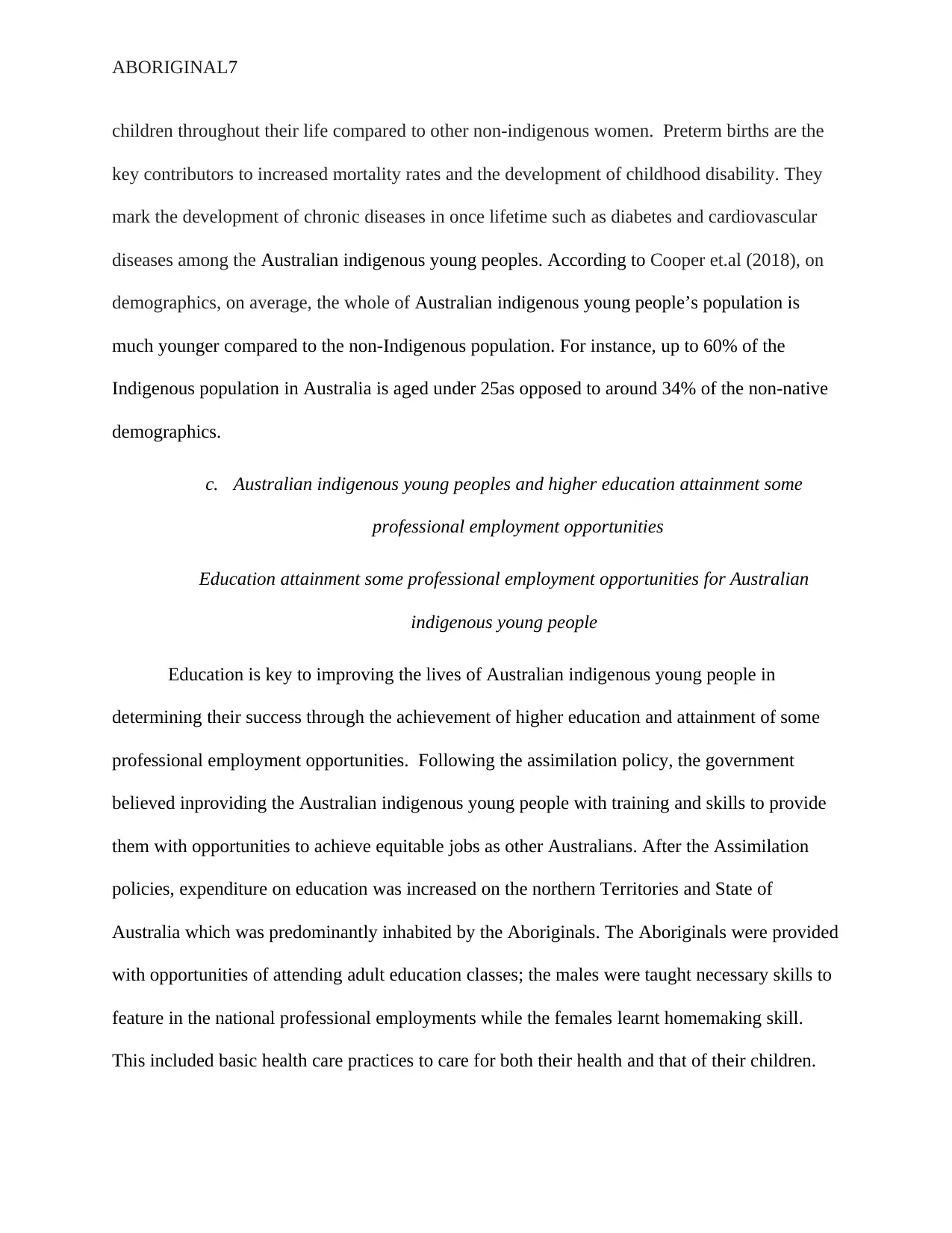
ABORIGINAL7
children throughout their life compared to other non-indigenous women. Preterm births are the
key contributors to increased mortality rates and the development of childhood disability. They
mark the development of chronic diseases in once lifetime such as diabetes and cardiovascular
diseases among the Australian indigenous young peoples. According to Cooper et.al (2018), on
demographics, on average, the whole of Australian indigenous young people’s population is
much younger compared to the non-Indigenous population. For instance, up to 60% of the
Indigenous population in Australia is aged under 25as opposed to around 34% of the non-native
demographics.
c. Australian indigenous young peoples and higher education attainment some
professional employment opportunities
Education attainment some professional employment opportunities for Australian
indigenous young people
Education is key to improving the lives of Australian indigenous young people in
determining their success through the achievement of higher education and attainment of some
professional employment opportunities. Following the assimilation policy, the government
believed inproviding the Australian indigenous young people with training and skills to provide
them with opportunities to achieve equitable jobs as other Australians. After the Assimilation
policies, expenditure on education was increased on the northern Territories and State of
Australia which was predominantly inhabited by the Aboriginals. The Aboriginals were provided
with opportunities of attending adult education classes; the males were taught necessary skills to
feature in the national professional employments while the females learnt homemaking skill.
This included basic health care practices to care for both their health and that of their children.
children throughout their life compared to other non-indigenous women. Preterm births are the
key contributors to increased mortality rates and the development of childhood disability. They
mark the development of chronic diseases in once lifetime such as diabetes and cardiovascular
diseases among the Australian indigenous young peoples. According to Cooper et.al (2018), on
demographics, on average, the whole of Australian indigenous young people’s population is
much younger compared to the non-Indigenous population. For instance, up to 60% of the
Indigenous population in Australia is aged under 25as opposed to around 34% of the non-native
demographics.
c. Australian indigenous young peoples and higher education attainment some
professional employment opportunities
Education attainment some professional employment opportunities for Australian
indigenous young people
Education is key to improving the lives of Australian indigenous young people in
determining their success through the achievement of higher education and attainment of some
professional employment opportunities. Following the assimilation policy, the government
believed inproviding the Australian indigenous young people with training and skills to provide
them with opportunities to achieve equitable jobs as other Australians. After the Assimilation
policies, expenditure on education was increased on the northern Territories and State of
Australia which was predominantly inhabited by the Aboriginals. The Aboriginals were provided
with opportunities of attending adult education classes; the males were taught necessary skills to
feature in the national professional employments while the females learnt homemaking skill.
This included basic health care practices to care for both their health and that of their children.
Paraphrase This Document
Need a fresh take? Get an instant paraphrase of this document with our AI Paraphraser
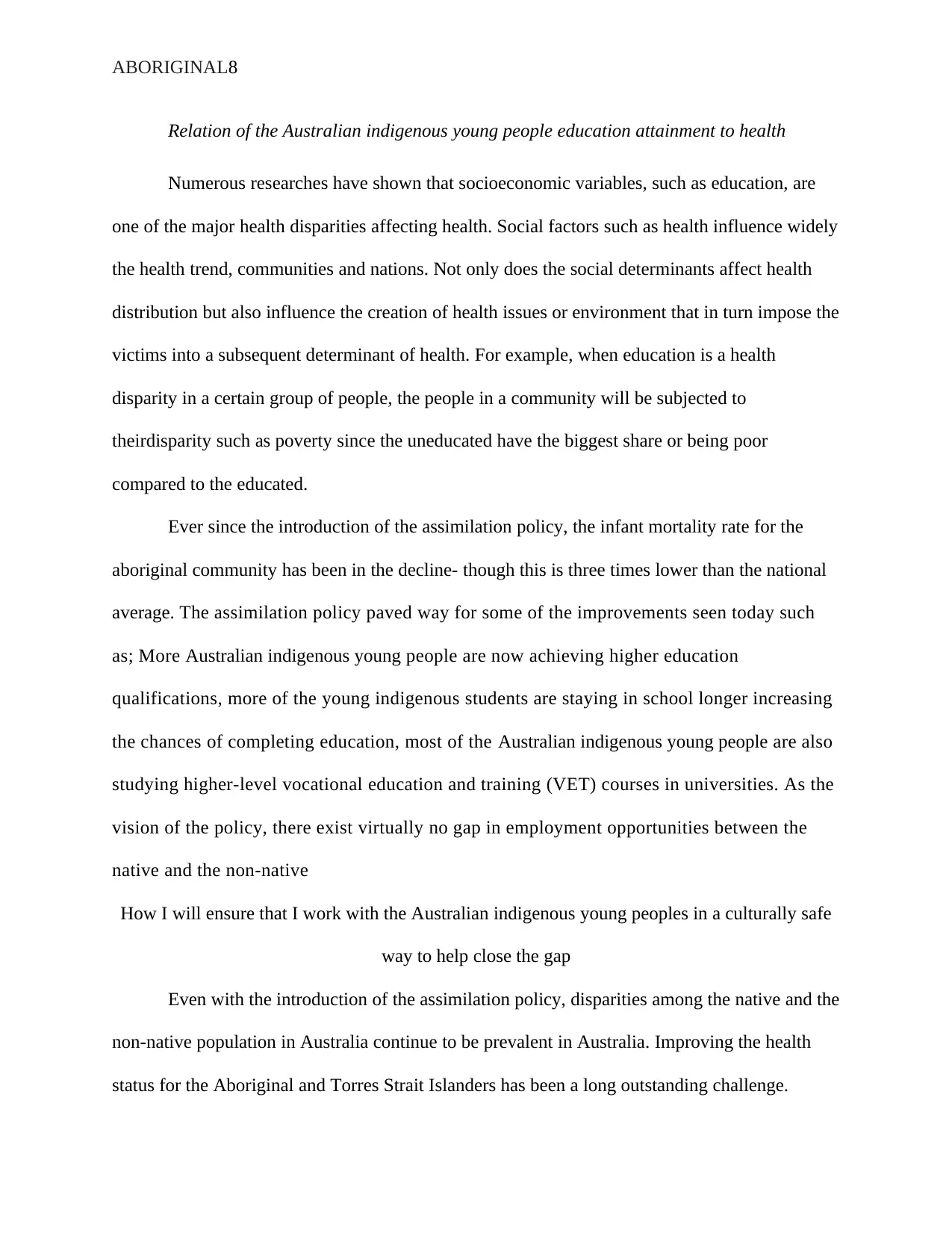
ABORIGINAL8
Relation of the Australian indigenous young people education attainment to health
Numerous researches have shown that socioeconomic variables, such as education, are
one of the major health disparities affecting health. Social factors such as health influence widely
the health trend, communities and nations. Not only does the social determinants affect health
distribution but also influence the creation of health issues or environment that in turn impose the
victims into a subsequent determinant of health. For example, when education is a health
disparity in a certain group of people, the people in a community will be subjected to
theirdisparity such as poverty since the uneducated have the biggest share or being poor
compared to the educated.
Ever since the introduction of the assimilation policy, the infant mortality rate for the
aboriginal community has been in the decline- though this is three times lower than the national
average. The assimilation policy paved way for some of the improvements seen today such
as; More Australian indigenous young people are now achieving higher education
qualifications, more of the young indigenous students are staying in school longer increasing
the chances of completing education, most of the Australian indigenous young people are also
studying higher-level vocational education and training (VET) courses in universities. As the
vision of the policy, there exist virtually no gap in employment opportunities between the
native and the non-native
How I will ensure that I work with the Australian indigenous young peoples in a culturally safe
way to help close the gap
Even with the introduction of the assimilation policy, disparities among the native and the
non-native population in Australia continue to be prevalent in Australia. Improving the health
status for the Aboriginal and Torres Strait Islanders has been a long outstanding challenge.
Relation of the Australian indigenous young people education attainment to health
Numerous researches have shown that socioeconomic variables, such as education, are
one of the major health disparities affecting health. Social factors such as health influence widely
the health trend, communities and nations. Not only does the social determinants affect health
distribution but also influence the creation of health issues or environment that in turn impose the
victims into a subsequent determinant of health. For example, when education is a health
disparity in a certain group of people, the people in a community will be subjected to
theirdisparity such as poverty since the uneducated have the biggest share or being poor
compared to the educated.
Ever since the introduction of the assimilation policy, the infant mortality rate for the
aboriginal community has been in the decline- though this is three times lower than the national
average. The assimilation policy paved way for some of the improvements seen today such
as; More Australian indigenous young people are now achieving higher education
qualifications, more of the young indigenous students are staying in school longer increasing
the chances of completing education, most of the Australian indigenous young people are also
studying higher-level vocational education and training (VET) courses in universities. As the
vision of the policy, there exist virtually no gap in employment opportunities between the
native and the non-native
How I will ensure that I work with the Australian indigenous young peoples in a culturally safe
way to help close the gap
Even with the introduction of the assimilation policy, disparities among the native and the
non-native population in Australia continue to be prevalent in Australia. Improving the health
status for the Aboriginal and Torres Strait Islanders has been a long outstanding challenge.
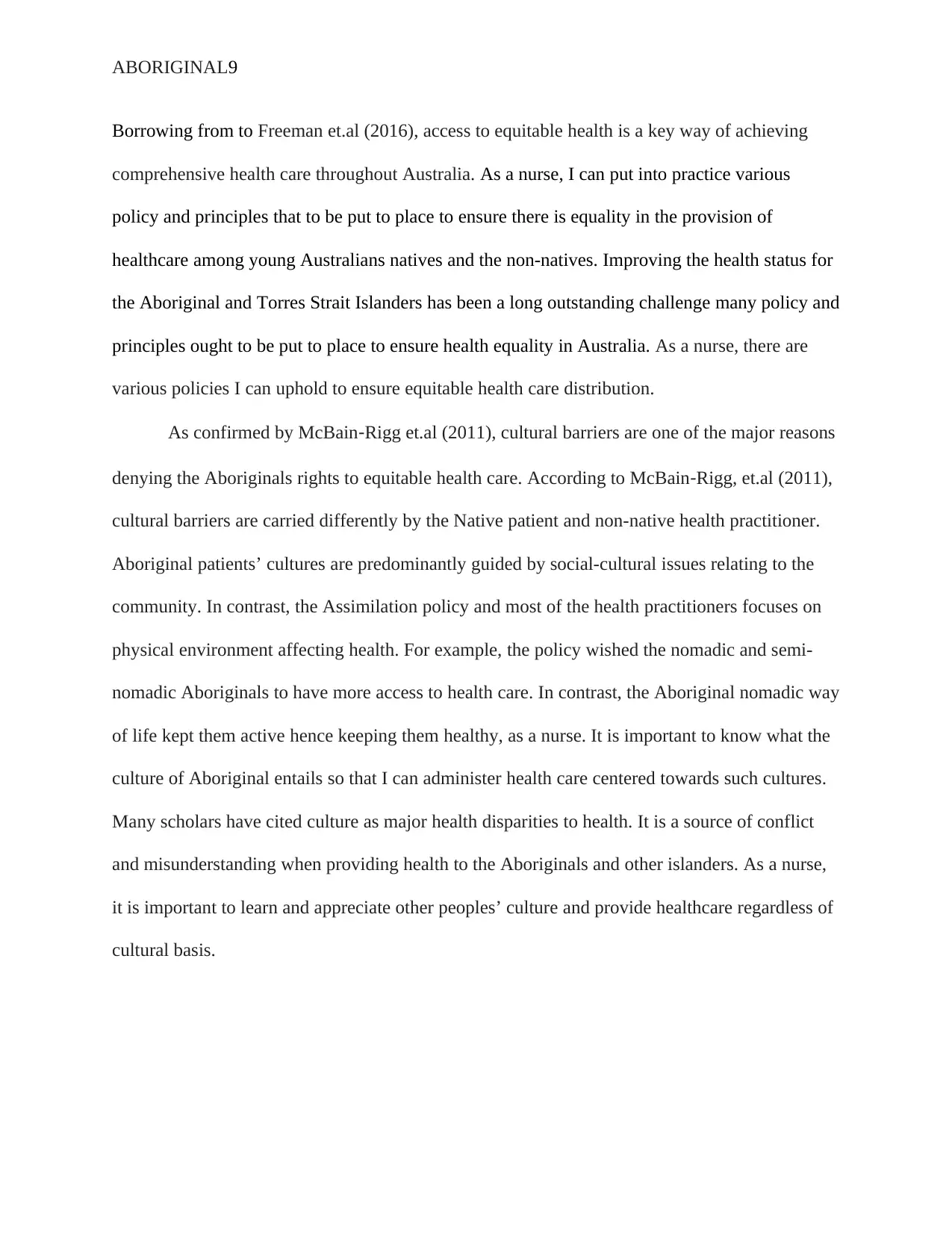
ABORIGINAL9
Borrowing from to Freeman et.al (2016), access to equitable health is a key way of achieving
comprehensive health care throughout Australia. As a nurse, I can put into practice various
policy and principles that to be put to place to ensure there is equality in the provision of
healthcare among young Australians natives and the non-natives. Improving the health status for
the Aboriginal and Torres Strait Islanders has been a long outstanding challenge many policy and
principles ought to be put to place to ensure health equality in Australia. As a nurse, there are
various policies I can uphold to ensure equitable health care distribution.
As confirmed by McBain‐Rigg et.al (2011), cultural barriers are one of the major reasons
denying the Aboriginals rights to equitable health care. According to McBain‐Rigg, et.al (2011),
cultural barriers are carried differently by the Native patient and non-native health practitioner.
Aboriginal patients’ cultures are predominantly guided by social-cultural issues relating to the
community. In contrast, the Assimilation policy and most of the health practitioners focuses on
physical environment affecting health. For example, the policy wished the nomadic and semi-
nomadic Aboriginals to have more access to health care. In contrast, the Aboriginal nomadic way
of life kept them active hence keeping them healthy, as a nurse. It is important to know what the
culture of Aboriginal entails so that I can administer health care centered towards such cultures.
Many scholars have cited culture as major health disparities to health. It is a source of conflict
and misunderstanding when providing health to the Aboriginals and other islanders. As a nurse,
it is important to learn and appreciate other peoples’ culture and provide healthcare regardless of
cultural basis.
Borrowing from to Freeman et.al (2016), access to equitable health is a key way of achieving
comprehensive health care throughout Australia. As a nurse, I can put into practice various
policy and principles that to be put to place to ensure there is equality in the provision of
healthcare among young Australians natives and the non-natives. Improving the health status for
the Aboriginal and Torres Strait Islanders has been a long outstanding challenge many policy and
principles ought to be put to place to ensure health equality in Australia. As a nurse, there are
various policies I can uphold to ensure equitable health care distribution.
As confirmed by McBain‐Rigg et.al (2011), cultural barriers are one of the major reasons
denying the Aboriginals rights to equitable health care. According to McBain‐Rigg, et.al (2011),
cultural barriers are carried differently by the Native patient and non-native health practitioner.
Aboriginal patients’ cultures are predominantly guided by social-cultural issues relating to the
community. In contrast, the Assimilation policy and most of the health practitioners focuses on
physical environment affecting health. For example, the policy wished the nomadic and semi-
nomadic Aboriginals to have more access to health care. In contrast, the Aboriginal nomadic way
of life kept them active hence keeping them healthy, as a nurse. It is important to know what the
culture of Aboriginal entails so that I can administer health care centered towards such cultures.
Many scholars have cited culture as major health disparities to health. It is a source of conflict
and misunderstanding when providing health to the Aboriginals and other islanders. As a nurse,
it is important to learn and appreciate other peoples’ culture and provide healthcare regardless of
cultural basis.
⊘ This is a preview!⊘
Do you want full access?
Subscribe today to unlock all pages.

Trusted by 1+ million students worldwide
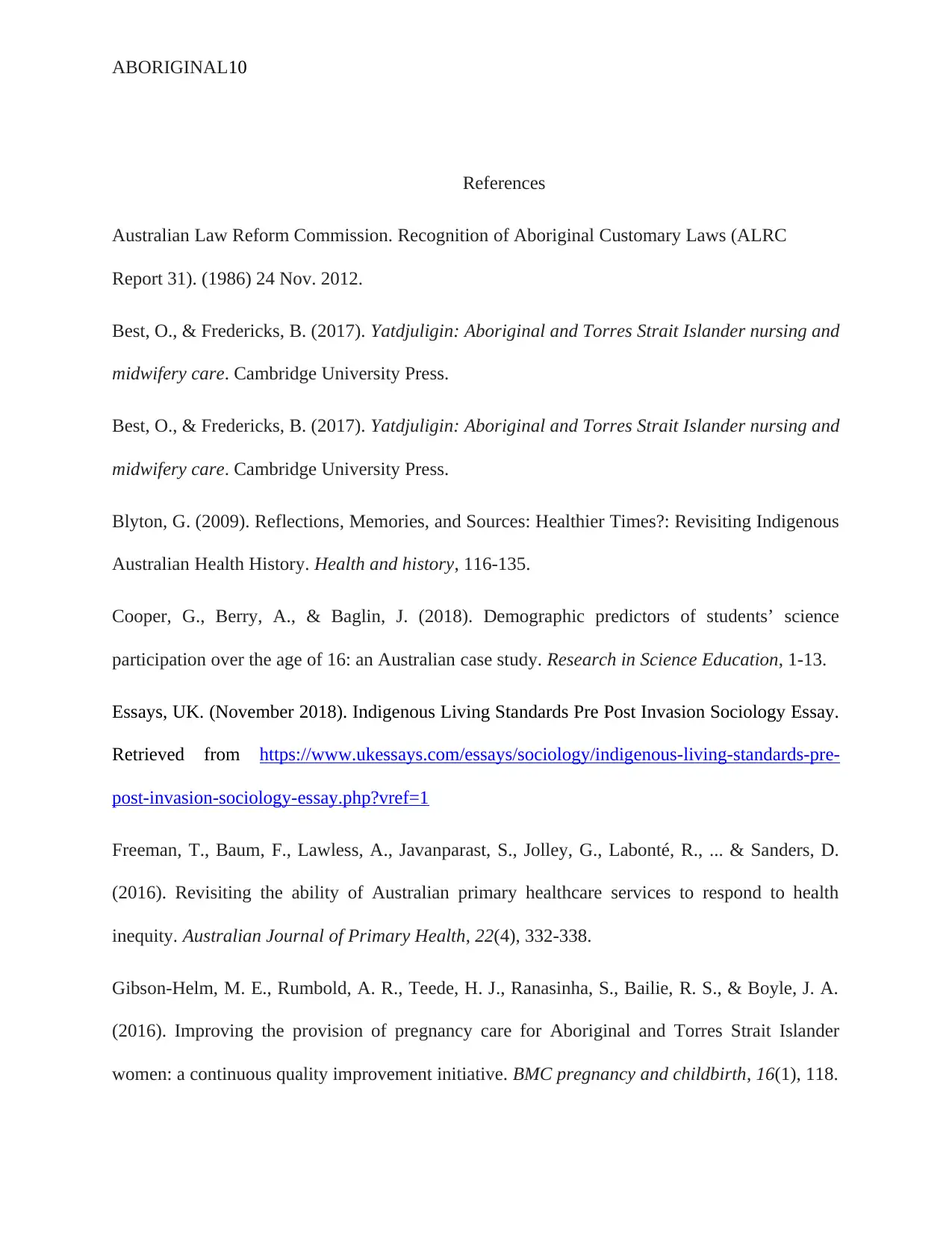
ABORIGINAL10
References
Australian Law Reform Commission. Recognition of Aboriginal Customary Laws (ALRC
Report 31). (1986) 24 Nov. 2012.
Best, O., & Fredericks, B. (2017). Yatdjuligin: Aboriginal and Torres Strait Islander nursing and
midwifery care. Cambridge University Press.
Best, O., & Fredericks, B. (2017). Yatdjuligin: Aboriginal and Torres Strait Islander nursing and
midwifery care. Cambridge University Press.
Blyton, G. (2009). Reflections, Memories, and Sources: Healthier Times?: Revisiting Indigenous
Australian Health History. Health and history, 116-135.
Cooper, G., Berry, A., & Baglin, J. (2018). Demographic predictors of students’ science
participation over the age of 16: an Australian case study. Research in Science Education, 1-13.
Essays, UK. (November 2018). Indigenous Living Standards Pre Post Invasion Sociology Essay.
Retrieved from https://www.ukessays.com/essays/sociology/indigenous-living-standards-pre-
post-invasion-sociology-essay.php?vref=1
Freeman, T., Baum, F., Lawless, A., Javanparast, S., Jolley, G., Labonté, R., ... & Sanders, D.
(2016). Revisiting the ability of Australian primary healthcare services to respond to health
inequity. Australian Journal of Primary Health, 22(4), 332-338.
Gibson-Helm, M. E., Rumbold, A. R., Teede, H. J., Ranasinha, S., Bailie, R. S., & Boyle, J. A.
(2016). Improving the provision of pregnancy care for Aboriginal and Torres Strait Islander
women: a continuous quality improvement initiative. BMC pregnancy and childbirth, 16(1), 118.
References
Australian Law Reform Commission. Recognition of Aboriginal Customary Laws (ALRC
Report 31). (1986) 24 Nov. 2012.
Best, O., & Fredericks, B. (2017). Yatdjuligin: Aboriginal and Torres Strait Islander nursing and
midwifery care. Cambridge University Press.
Best, O., & Fredericks, B. (2017). Yatdjuligin: Aboriginal and Torres Strait Islander nursing and
midwifery care. Cambridge University Press.
Blyton, G. (2009). Reflections, Memories, and Sources: Healthier Times?: Revisiting Indigenous
Australian Health History. Health and history, 116-135.
Cooper, G., Berry, A., & Baglin, J. (2018). Demographic predictors of students’ science
participation over the age of 16: an Australian case study. Research in Science Education, 1-13.
Essays, UK. (November 2018). Indigenous Living Standards Pre Post Invasion Sociology Essay.
Retrieved from https://www.ukessays.com/essays/sociology/indigenous-living-standards-pre-
post-invasion-sociology-essay.php?vref=1
Freeman, T., Baum, F., Lawless, A., Javanparast, S., Jolley, G., Labonté, R., ... & Sanders, D.
(2016). Revisiting the ability of Australian primary healthcare services to respond to health
inequity. Australian Journal of Primary Health, 22(4), 332-338.
Gibson-Helm, M. E., Rumbold, A. R., Teede, H. J., Ranasinha, S., Bailie, R. S., & Boyle, J. A.
(2016). Improving the provision of pregnancy care for Aboriginal and Torres Strait Islander
women: a continuous quality improvement initiative. BMC pregnancy and childbirth, 16(1), 118.
Paraphrase This Document
Need a fresh take? Get an instant paraphrase of this document with our AI Paraphraser
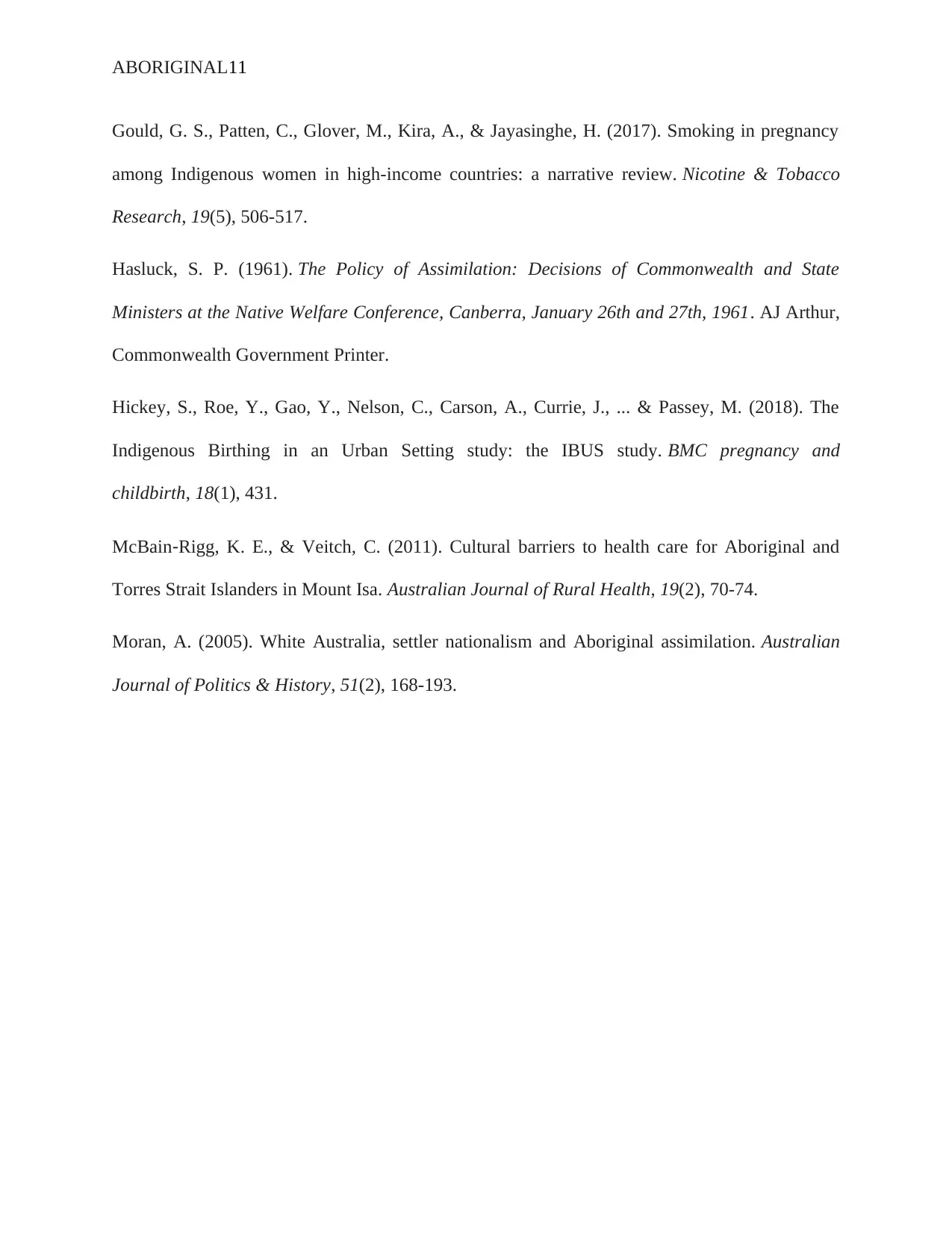
ABORIGINAL11
Gould, G. S., Patten, C., Glover, M., Kira, A., & Jayasinghe, H. (2017). Smoking in pregnancy
among Indigenous women in high-income countries: a narrative review. Nicotine & Tobacco
Research, 19(5), 506-517.
Hasluck, S. P. (1961). The Policy of Assimilation: Decisions of Commonwealth and State
Ministers at the Native Welfare Conference, Canberra, January 26th and 27th, 1961. AJ Arthur,
Commonwealth Government Printer.
Hickey, S., Roe, Y., Gao, Y., Nelson, C., Carson, A., Currie, J., ... & Passey, M. (2018). The
Indigenous Birthing in an Urban Setting study: the IBUS study. BMC pregnancy and
childbirth, 18(1), 431.
McBain‐Rigg, K. E., & Veitch, C. (2011). Cultural barriers to health care for Aboriginal and
Torres Strait Islanders in Mount Isa. Australian Journal of Rural Health, 19(2), 70-74.
Moran, A. (2005). White Australia, settler nationalism and Aboriginal assimilation. Australian
Journal of Politics & History, 51(2), 168-193.
Gould, G. S., Patten, C., Glover, M., Kira, A., & Jayasinghe, H. (2017). Smoking in pregnancy
among Indigenous women in high-income countries: a narrative review. Nicotine & Tobacco
Research, 19(5), 506-517.
Hasluck, S. P. (1961). The Policy of Assimilation: Decisions of Commonwealth and State
Ministers at the Native Welfare Conference, Canberra, January 26th and 27th, 1961. AJ Arthur,
Commonwealth Government Printer.
Hickey, S., Roe, Y., Gao, Y., Nelson, C., Carson, A., Currie, J., ... & Passey, M. (2018). The
Indigenous Birthing in an Urban Setting study: the IBUS study. BMC pregnancy and
childbirth, 18(1), 431.
McBain‐Rigg, K. E., & Veitch, C. (2011). Cultural barriers to health care for Aboriginal and
Torres Strait Islanders in Mount Isa. Australian Journal of Rural Health, 19(2), 70-74.
Moran, A. (2005). White Australia, settler nationalism and Aboriginal assimilation. Australian
Journal of Politics & History, 51(2), 168-193.
1 out of 11
Related Documents
Your All-in-One AI-Powered Toolkit for Academic Success.
+13062052269
info@desklib.com
Available 24*7 on WhatsApp / Email
![[object Object]](/_next/static/media/star-bottom.7253800d.svg)
Unlock your academic potential
Copyright © 2020–2025 A2Z Services. All Rights Reserved. Developed and managed by ZUCOL.





